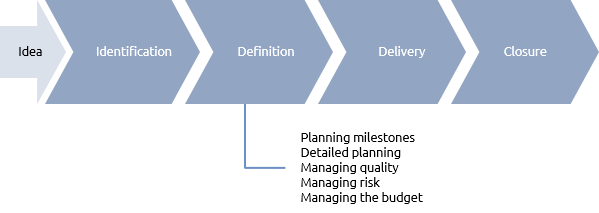A project follows a life cycle, starting with the beginning and finishing at the end. Of course, since project management is a branch of scientific management, we cannot use terms as prosaic as ‘beginning’ and ‘end’.

In generic terms a project follows the phases shown above. It is instructive to realise that a significant amount of project management activity is carried out before the work of delivering the project gets under way.
There are four reasons why these phases are important. They set the theme for much of what project management is about:
-
Before we start any real work we must agree what it is that we are trying to do, why we are doing it (usually from a business point of view) and finally what the success criteria are.
-
We should get a clear understanding of the way forward before we start.
-
If we are going to have argument and disagreement about the project it is best to have this at the start (the cheap end of the project) rather than at the finish (the expensive end).
-
If there are areas of uncertainty these should be identified and understood at the start.
If we can have discussions about these parameters at the beginning then, if we have disagreement, it will be easier to amend the project. If we have the discussion at the end, when we have delivered the wrong thing, we (the organisation) are stuck with a failed project.
Every project passes through these phases. A very small project may pass through identification and definition very quickly, whereas the identification of a complex project (such as part of an Olympic Games) may take months, and involve dozens of people.
Identification

There are three main activities in the identification phase:
-
Identify objectives: get agreement to what it is we are trying to do, and why. We are definitely not making commitments about the how.
-
Define roles and responsibilities: identify the key players, and set out their responsibilities.
-
Manage stakeholders: identify the other players in the project, and start thinking about what they want, and where they might be coming from.
Definition

There are five main activities in the definition phase:
-
Plan milestones: establishing a structure or framework for the project, by identifying key decision points linked to the production of major deliverables.
-
Plan detail: sorting out the detail of who will do what, how and when.
-
Manage quality: making sure that the project delivers quality end and component products.
-
Manage risk: enhancing the robustness of the project plan by planning to manage risks in advance.
-
Manage the budget: identifying where the money will be spent.
Delivery

There are three main activities in the delivery phase:
-
Start the activities: making sure that activities actually start when you want them to start.
-
Control progress: measuring progress, taking corrective actions, reporting progress.
-
Control changes: dealing with the inevitable requests for change in an orderly manner.
Closure

There are two main activities in the closure phase:
-
Close the project: making sure that the customer is happy with the end result, dealing with outstanding issues, and closing the files
-
Learn how to improve: taking a constructive look back at the way you managed the project, in order to get it better next time.
Why follow such a process?
The processes outlined above might seem like a lot of long-winded bureaucracy, but put yourself in the shoes of your project sponsor (probably the person who will pay for the project, but certainly the person who wants the outcome).
If the sponsor asks you “..and how will you run this project?”, your reply could be one of the following:
-
“Well, I’m going to make it up as I go along, as I find that this is a much more flexible and exciting way to do it.”
-
“Well, I’m not really sure.”
-
“Let’s just wait and see what happens, shall we?”
-
“I don’t like the company standard methodology, so I’m going to use common sense.”
Not only does a well thought-out structure approach help the sponsor (in underlining your credibility, and so on), but it will also help you. Why on earth would you wish to reinvent the wheel, when you can use an approach that has been used successfully many times?
Summary
The fool learns from his mistakes; the wise man learns from the mistakes of others. Tap into a rich vein of project management expertise by following an approach that has a track record on a wide range of project types.
Further reading
These links to the main Praxis Framework explain how the concepts introduced in this chapter can be applied to projects that involve more people and more complex relationships.
The phases introduced in this chapter are expanded to show how they apply to more complex projects and programmes. | |
An overview of the Praxis process model for projects and programmes. |
Thanks to Mike Watson of Obsideo for providing this book





